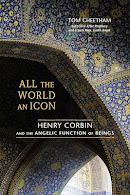"...the Imagination (or love, or sympathy, or any other sentiment) induces knowledge, and knowledge of an 'object' which is proper to it..."
Henry Corbin (1903-1978) was a scholar, philosopher and theologian. He was a champion of the transformative power of the Imagination and of the transcendent reality of the individual in a world threatened by totalitarianisms of all kinds. One of the 20th century’s most prolific scholars of Islamic mysticism, Corbin was Professor of Islam & Islamic Philosophy at the Sorbonne in Paris and at the University of Teheran. He was a major figure at the Eranos Conferences in Switzerland. He introduced the concept of the mundus imaginalis into contemporary thought. His work has provided a foundation for archetypal psychology as developed by James Hillman and influenced countless poets and artists worldwide. But Corbin’s central project was to provide a framework for understanding the unity of the religions of the Book: Judaism, Christianity and Islam. His great work Alone with the Alone: Creative Imagination in the Sufism of Ibn ‘Arabi is a classic initiatory text of visionary spirituality that transcends the tragic divisions among the three great monotheisms. Corbin’s life was devoted to the struggle to free the religious imagination from fundamentalisms of every kind. His work marks a watershed in our understanding of the religions of the West and makes a profound contribution to the study of the place of the imagination in human life.Search The Legacy of Henry Corbin: Over 800 Posts
Monday, December 31, 2012
Friday, December 28, 2012
An Incredible Photo Archive
Daniel Proulx has put up 219 more photos in the Henry Corbin Archive - there are 250 more coming soon. These are a treasure and absolutely fascinating.
Wednesday, December 26, 2012
The Esoteric Apocalypse - Isma‘ilī Muslim Perspectives
“It is said, for example, that the Qā’im, the aim and goal of all the hudūd, the degrees or “horizons”, is the Grand Cycle of which the Imāms are the periods or partial cycles, just as each Imām is himself a cycle in relation to his ḥudūd. … It is also said that the Qā’im is the “coalescence” (majma), the corpus mysticum of all the ḥudūd; each of the Imāms has his own corpus mysticum, his Temple of Light, and all are gathered together and integrated in the Sublime Temple of the Resurrector. – Henry Corbin, (Cyclical Times and Ismaili Gnosis, 99)
Monday, December 24, 2012
Thursday, December 20, 2012
Saturday, December 15, 2012
Celestial Magic Conference
|
Tuesday, December 11, 2012
Gilbert Durand May 1, 1921 - Dec 7, 2012.
Décès de Gilbert Durand, résistant et anthropologue de l’imaginaire
From Le Soir:
Lundi 10 Décembre 2012
Gilbert Durand, ancien résistant du Vercors, directeur du Centre de recherche sur l’imaginaire et spécialiste de la mythologie, est décédé vendredi à l’âge de 91 ans, a annoncé lundi sa famille dans le carnet du Figaro. Né le 1er mai 1921 à Chambéry, Gilbert Durand avait rejoint la Résistance dès la fin de l’année 1940 et avait ensuite participé activement aux maquis du Vercors. Agrégé de philosophie et docteur ès lettres, Gilbert Durand fut professeur de philosophie, puis de sociologie et d’anthropologie à Grenoble II. Disciple de Gaston Bachelard, il avait co-fondé en 1966 le Centre de recherche sur l’imaginaire et dirigé cette structure autour de laquelle travaillèrent une soixantaine de laboratoires du monde entier. Gilbert Durand était l’auteur d’une quinzaine d’ouvrages, dont « Les structures anthropologiques de l’imaginaire’ (PUF, 1960), « L’imagination symbolique » (PUF, 1964), « La foi du cordonnier » (Denoël, 1984), ou « Les mythes fondateurs de la franc-maçonnerie » (Dervy, 2002). En 2000, il avait reçu le titre de « Juste parmi les nations », la plus haute distinction décernée par Israël à ceux qui ont sauvé au péril de leur vie des juifs pendant la guerre. En 2007, le grand résistant Raymond Aubrac lui avait remis la cravate de commandeur de la Légion d’honneur pour ses actions dans la Résistance. Gilbert Durand était également titulaire de la médaille de la Résistance avec rosette, de la Croix de guerre 1939-1945 avec palmes et commandeur des Palmes académiques.
Friday, December 7, 2012
The conferences de la Journée des amis de Corbin are now online.
Selected talks at the Conferences de la Journée des amis de Corbin are now online HERE
Many thanks to Daniel Proulx for his amazing work on the website...
Thursday, December 6, 2012
Henry Corbin and Iran, Islam, Philosophy and Revolution
Varzi is Associate Professor of Anthropology, Film and Media Studies, Visual Studies, Religious Studies, and Persian Studies, University of California, Irvine
The French Connection: Henry Corbin and Iran, Islam, Philosophy and Revolution
There’s no denying that Henry Corbin was an important part of Iranian history and Western philosophy and yet nothing has been written about his role in the pedagogy of the Iranian revolutionaries who were to bring about the Iranian Revolution or what he referred to as a “shadow of evil.” My project while at the IFK is to research and write on Corbin’s revolutionary legacy. More here.
Wednesday, December 5, 2012
New Translation of Nāṣir-i-Khusrow
From Wahid Nazal:
"The piece was summarized by Henry Corbin in several places including Cyclical Time and Isma'ili Gnosis, see especially pp. 36-37. To date, our translation appears to be the only full length translation of this entire section of the following work by Nāṣir-i-Khusrow. We note that additional to this blog entry, apdf of our translation below can also be found, here."
Monday, December 3, 2012
N. O. Brown, Corbin, Islam
An new essay online - from which,
To bring Islam into the historical picture is for Brown akin to a Copernican revolution: following in the steps of Marshall Hodgson, Louis Massignon, and Henry Corbin, with Brown “we are moving out from under the schema of Christocentric world history, stamped on the minds of orthodox Westerners . . . into ampler and more Islamic, air.”
Subscribe to:
Posts (Atom)









